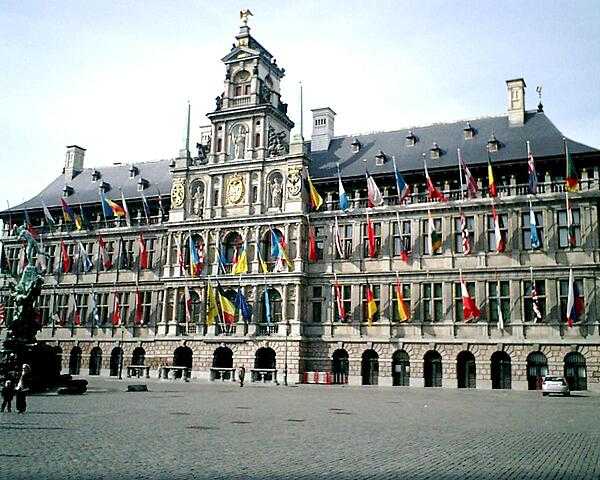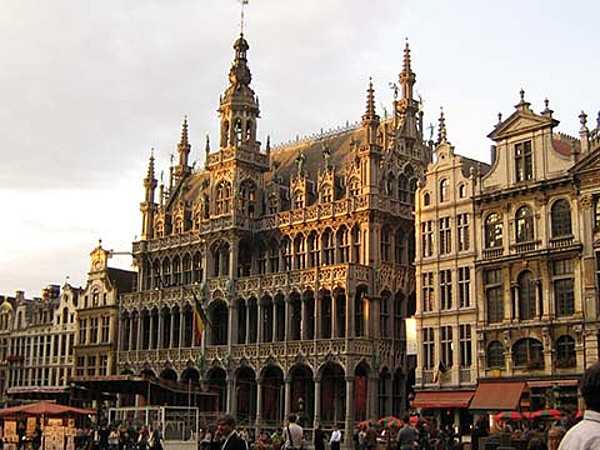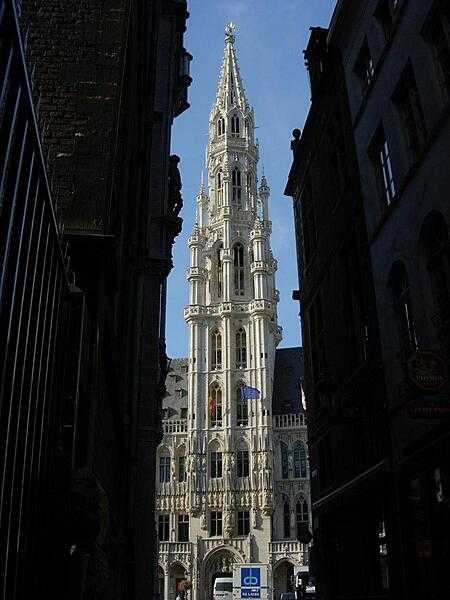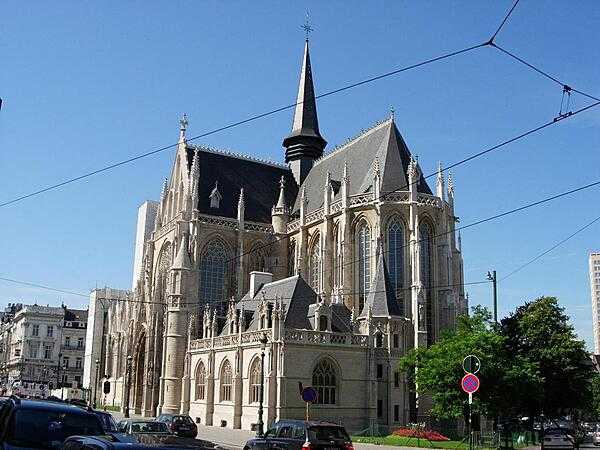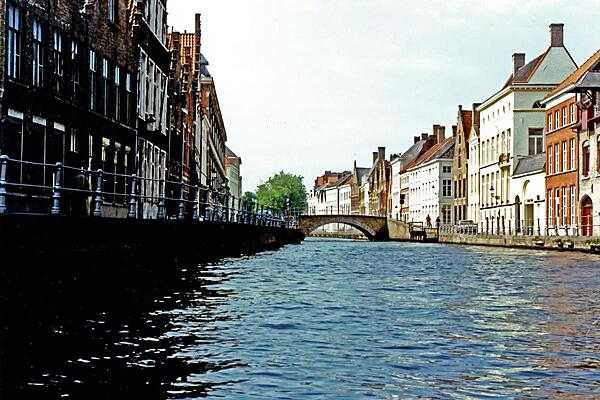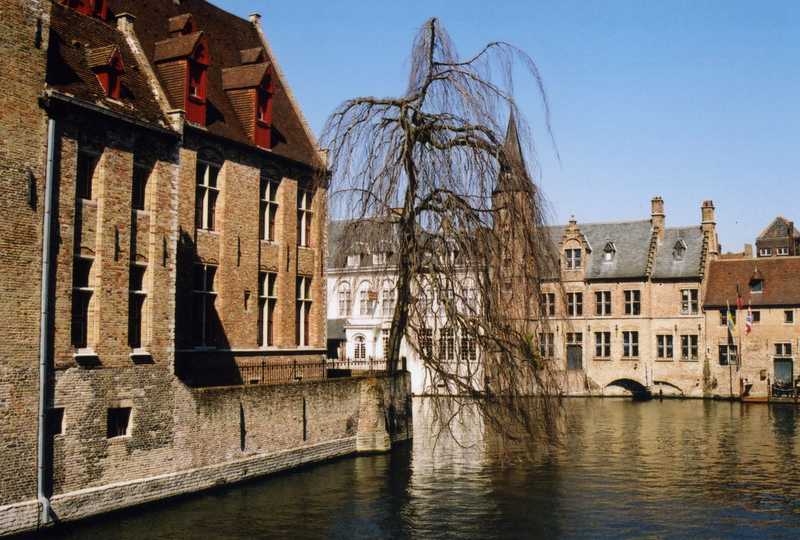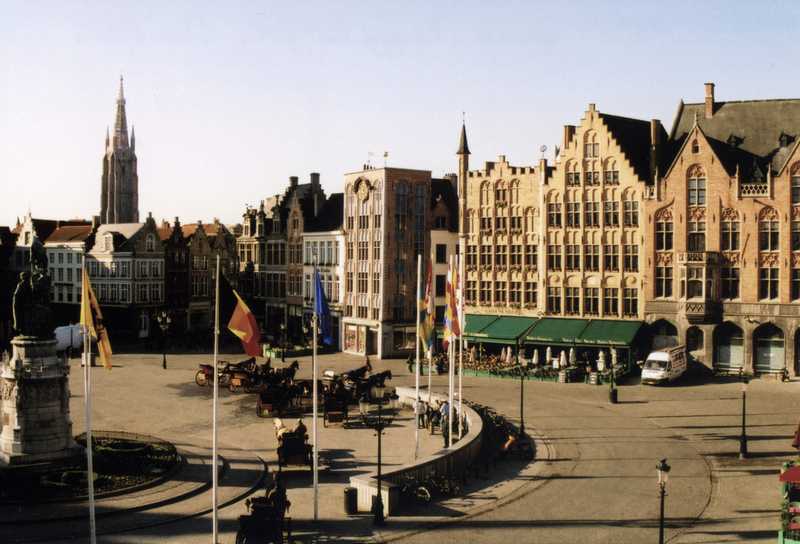Belgium - BE - BEL - BEL - Europe
Last updated: January 06, 2026



Belgium Images
Belgium Factbook Data
Diplomatic representation from the US
chief of mission: Ambassador Bill WHITE (since 17 November 2025)
embassy: Regentlaan 27 Boulevard du Regent, B-1000 Brussels
mailing address: 7600 Brussels Place, Washington DC 20521-7600
telephone: [32] (2) 811-4000
FAX: [32] (2) 811-4500
email address and website:
uscitizenBrussels@state.gov
https://be.usembassy.gov/
embassy: Regentlaan 27 Boulevard du Regent, B-1000 Brussels
mailing address: 7600 Brussels Place, Washington DC 20521-7600
telephone: [32] (2) 811-4000
FAX: [32] (2) 811-4500
email address and website:
uscitizenBrussels@state.gov
https://be.usembassy.gov/
Age structure
0-14 years: 16.9% (male 1,038,578/female 990,215)
15-64 years: 62.8% (male 3,796,844/female 3,730,784)
65 years and over: 20.2% (2024 est.) (male 1,073,635/female 1,347,578)
15-64 years: 62.8% (male 3,796,844/female 3,730,784)
65 years and over: 20.2% (2024 est.) (male 1,073,635/female 1,347,578)
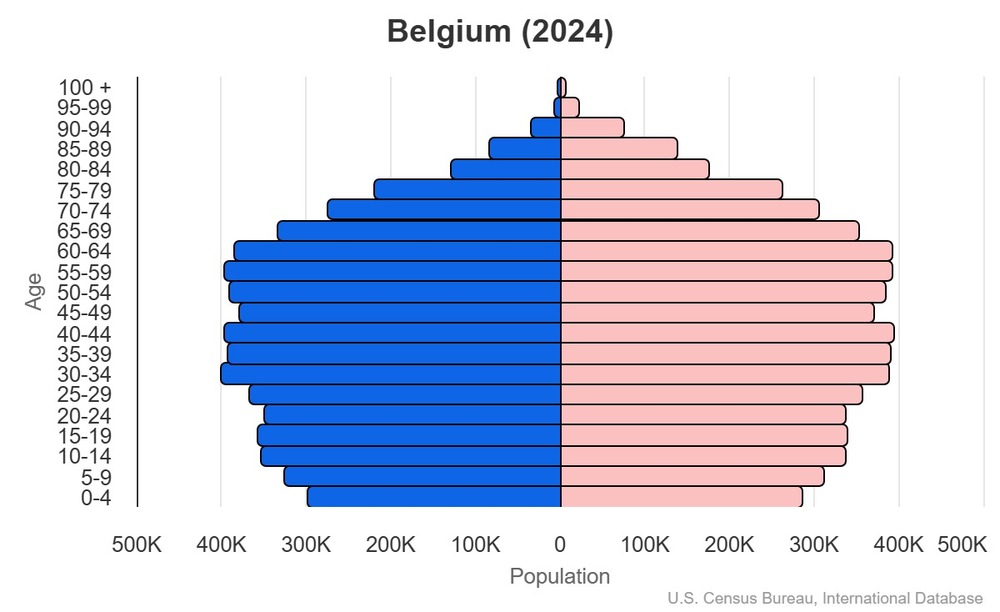
This is the population pyramid for Belgium. A population pyramid illustrates the age and sex structure of a country's population and may provide insights about political and social stability, as well as economic development. The population is distributed along the horizontal axis, with males shown on the left and females on the right. The male and female populations are broken down into 5-year age groups represented as horizontal bars along the vertical axis, with the youngest age groups at the bottom and the oldest at the top. The shape of the population pyramid gradually evolves over time based on fertility, mortality, and international migration trends.
For additional information, please see the entry for Population pyramid on the Definitions and Notes page.
For additional information, please see the entry for Population pyramid on the Definitions and Notes page.
Geographic coordinates
50 50 N, 4 00 E
Sex ratio
at birth: 1.05 male(s)/female
0-14 years: 1.05 male(s)/female
15-64 years: 1.02 male(s)/female
65 years and over: 0.8 male(s)/female
total population: 0.97 male(s)/female (2024 est.)
0-14 years: 1.05 male(s)/female
15-64 years: 1.02 male(s)/female
65 years and over: 0.8 male(s)/female
total population: 0.97 male(s)/female (2024 est.)
Natural hazards
flooding is a threat along rivers and in areas of reclaimed coastal land, protected from the sea by concrete dikes
Area - comparative
about the size of Maryland

about the size of Maryland
Background
Belgium became independent from the Netherlands in 1830; it was occupied by Germany during World Wars I and II. The country prospered as a modern, technologically advanced European state and member of NATO and the EU. In recent years, longstanding tensions between the Dutch-speaking Flemish of the north and the French-speaking Walloons of the south have led to constitutional amendments granting these regions formal recognition and autonomy. The capital city of Brussels is home to numerous international organizations, including the EU and NATO.
Environmental issues
urbanization; possible risks from industry and intensive farming; air and water pollution
International environmental agreements
party to: Air Pollution, Air Pollution-Heavy Metals, Air Pollution-Multi-effect Protocol, Air Pollution-Nitrogen Oxides, Air Pollution-Persistent Organic Pollutants, Air Pollution-Sulphur 85, Air Pollution-Sulphur 94, Air Pollution-Volatile Organic Compounds, Antarctic-Environmental Protection, Antarctic-Marine Living Resources, Antarctic Seals, Antarctic Treaty, Biodiversity, Climate Change, Climate Change-Kyoto Protocol, Climate Change-Paris Agreement, Comprehensive Nuclear Test Ban, Desertification, Endangered Species, Environmental Modification, Hazardous Wastes, Law of the Sea, Marine Dumping-London Convention, Marine Dumping-London Protocol, Marine Life Conservation, Nuclear Test Ban, Ozone Layer Protection, Ship Pollution, Tropical Timber 2006, Wetlands, Whaling
signed, but not ratified: none of the selected agreements
signed, but not ratified: none of the selected agreements
Military expenditures
2% of GDP (2025 est.)
1.3% of GDP (2024 est.)
1.2% of GDP (2023 est.)
1.2% of GDP (2022 est.)
1.1% of GDP (2021 est.)
1.3% of GDP (2024 est.)
1.2% of GDP (2023 est.)
1.2% of GDP (2022 est.)
1.1% of GDP (2021 est.)
Population below poverty line
12.3% (2022 est.)
note: % of population with income below national poverty line
note: % of population with income below national poverty line
Household income or consumption by percentage share
lowest 10%: 3.8% (2022 est.)
highest 10%: 22.2% (2022 est.)
note: % share of income accruing to lowest and highest 10% of population
highest 10%: 22.2% (2022 est.)
note: % share of income accruing to lowest and highest 10% of population
Exports - commodities
refined petroleum, natural gas, vaccines, cars, packaged medicine (2023)
note: top five export commodities based on value in dollars
note: top five export commodities based on value in dollars
Exports - partners
France 20%, Netherlands 15%, Germany 14%, Italy 6%, USA 5% (2023)
note: top five export partners based on percentage share of exports
note: top five export partners based on percentage share of exports
Administrative divisions
3 regions (French: régions, singular - région; Dutch: gewesten, singular - gewest); Brussels-Capital Region, also known as Brussels Hoofdstedelijk Gewest (Dutch), Région de Bruxelles-Capitale (French long form), Bruxelles-Capitale (French short form); Flemish Region (Flanders), also known as Vlaams Gewest (Dutch long form), Vlaanderen (Dutch short form), Région Flamande (French long form), Flandre (French short form); Walloon Region (Wallonia), also known as Région Wallonne (French long form), Wallonie (French short form), Waals Gewest (Dutch long form), Wallonie (Dutch short form)
note: as a result of the 1993 constitutional revision that furthered devolution into a federal state, there are now three levels of government (federal, regional, and linguistic community) with a complex division of responsibilities; the 2012 sixth state reform transferred additional competencies from the federal state to the regions and linguistic communities
note: as a result of the 1993 constitutional revision that furthered devolution into a federal state, there are now three levels of government (federal, regional, and linguistic community) with a complex division of responsibilities; the 2012 sixth state reform transferred additional competencies from the federal state to the regions and linguistic communities
Agricultural products
sugar beets, milk, potatoes, wheat, pork, lettuce, maize, chicken, barley, pears (2023)
note: top ten agricultural products based on tonnage
note: top ten agricultural products based on tonnage
Military and security forces
Belgian Armed Forces (Defensie or La Défense): Land Component, Marine (Naval) Component, Air Component, Medical Component, Cyber Command (2025)
note: the Belgian Federal Police is the national police force and responsible for internal security and nationwide law and order, including migration and border enforcement
note: the Belgian Federal Police is the national police force and responsible for internal security and nationwide law and order, including migration and border enforcement
Budget
revenues: $220.657 billion (2022 est.)
expenditures: $235.767 billion (2022 est.)
note: central government revenues (excluding grants) and expenditures converted to US dollars at average official exchange rate for year indicated
expenditures: $235.767 billion (2022 est.)
note: central government revenues (excluding grants) and expenditures converted to US dollars at average official exchange rate for year indicated
Capital
name: Brussels
geographic coordinates: 50 84 N, 4 35 E
time difference: UTC+1 (6 hours ahead of Washington, DC, during Standard Time)
daylight saving time: +1hr, begins last Sunday in March; ends last Sunday in October
etymology: the name is of Germanic origin, from broca (marsh) and sali (room or building)
geographic coordinates: 50 84 N, 4 35 E
time difference: UTC+1 (6 hours ahead of Washington, DC, during Standard Time)
daylight saving time: +1hr, begins last Sunday in March; ends last Sunday in October
etymology: the name is of Germanic origin, from broca (marsh) and sali (room or building)
Imports - commodities
cars, natural gas, vaccines, packaged medicine, crude petroleum (2023)
note: top five import commodities based on value in dollars
note: top five import commodities based on value in dollars
Climate
temperate; mild winters, cool summers; rainy, humid, cloudy
Coastline
66.5 km
Constitution
history: drafted 25 November 1830, approved 7 February 1831, entered into force 26 July 1831, revised 14 July 1993 (creating a federal state)
amendment process: "revisions" proposed as declarations by the federal government in accord with the king or by Parliament followed by dissolution of Parliament and new elections; adoption requires two-thirds majority vote of a two-thirds quorum in both houses of the next elected Parliament
amendment process: "revisions" proposed as declarations by the federal government in accord with the king or by Parliament followed by dissolution of Parliament and new elections; adoption requires two-thirds majority vote of a two-thirds quorum in both houses of the next elected Parliament
Exchange rates
euros (EUR) per US dollar -
Exchange rates:
0.924 (2024 est.)
0.925 (2023 est.)
0.95 (2022 est.)
0.845 (2021 est.)
0.876 (2020 est.)
Exchange rates:
0.924 (2024 est.)
0.925 (2023 est.)
0.95 (2022 est.)
0.845 (2021 est.)
0.876 (2020 est.)
Executive branch
chief of state: King PHILIPPE (since 21 July 2013)
head of government: Prime Minister Bart DE WEVER (since 3 February 2025)
cabinet: Council of Ministers formally appointed by the monarch
election/appointment process: the monarchy is hereditary and constitutional; following legislative elections, the monarch usually appoints the leader of the majority party or majority coalition as prime minister, which the legislature approves
head of government: Prime Minister Bart DE WEVER (since 3 February 2025)
cabinet: Council of Ministers formally appointed by the monarch
election/appointment process: the monarchy is hereditary and constitutional; following legislative elections, the monarch usually appoints the leader of the majority party or majority coalition as prime minister, which the legislature approves
Flag
description: three equal vertical bands of black (left side), yellow, and red
history: the vertical design was based on the flag of France; the colors are from the arms of the duchy of Brabant (yellow lion with red claws and tongue on a black field)
history: the vertical design was based on the flag of France; the colors are from the arms of the duchy of Brabant (yellow lion with red claws and tongue on a black field)
Illicit drugs
USG identification:
major precursor-chemical producer (2025)
major precursor-chemical producer (2025)
Independence
4 October 1830 (a provisional government declared independence from the Netherlands); 21 July 1831 (King LEOPOLD I ascended to the throne)
Industries
engineering and metal products, motor vehicle assembly, transportation equipment, scientific instruments, processed food and beverages, chemicals, pharmaceuticals, base metals, textiles, glass, petroleum
Judicial branch
highest court(s): Constitutional Court or Grondwettelijk Hof (in Dutch) and Cour Constitutionelle (in French) (consists of 12 judges - 6 Dutch-speaking and 6 French-speaking); Supreme Court of Justice or Hof van Cassatie (in Dutch) and Cour de Cassation (in French) (court organized into 3 chambers: civil and commercial; criminal; social, fiscal, and armed forces; each chamber includes a Dutch division and a French division, each with a chairperson and 5-6 judges)
judge selection and term of office: Constitutional Court judges appointed by the monarch from candidates submitted by Parliament; judges appointed for life with mandatory retirement at age 70; Supreme Court judges appointed by the monarch from candidates submitted by the High Council of Justice, a 44-member independent body of judicial and non-judicial members; judges appointed for life
subordinate courts: Courts of Appeal; regional courts; specialized courts for administrative, commercial, labor, immigration, and audit issues; magistrate's courts; justices of the peace
judge selection and term of office: Constitutional Court judges appointed by the monarch from candidates submitted by Parliament; judges appointed for life with mandatory retirement at age 70; Supreme Court judges appointed by the monarch from candidates submitted by the High Council of Justice, a 44-member independent body of judicial and non-judicial members; judges appointed for life
subordinate courts: Courts of Appeal; regional courts; specialized courts for administrative, commercial, labor, immigration, and audit issues; magistrate's courts; justices of the peace
Land boundaries
total: 1,297 km
border countries (4): France 556 km; Germany 133 km; Luxembourg 130 km; Netherlands 478 km
border countries (4): France 556 km; Germany 133 km; Luxembourg 130 km; Netherlands 478 km
Land use
agricultural land: 44.4% (2023 est.)
arable land: 28.3% (2023 est.)
permanent crops: 0.8% (2023 est.)
permanent pasture: 15.3% (2023 est.)
forest: 22% (2023 est.)
other: 33.6% (2023 est.)
arable land: 28.3% (2023 est.)
permanent crops: 0.8% (2023 est.)
permanent pasture: 15.3% (2023 est.)
forest: 22% (2023 est.)
other: 33.6% (2023 est.)
Legal system
civil law system based on the French Civil Code; judicial review of legislative acts
Legislative branch
legislature name: Federal Parliament (Parlement fédéral - Federaal Parlement - Föderales Parlament)
legislative structure: bicameral
note: the 1993 constitutional revision that further devolved Belgium into a federal state created three levels of government (federal, regional, and linguistic community) with a complex division of responsibilities; this results in six governments, each with its own legislative assembly
legislative structure: bicameral
note: the 1993 constitutional revision that further devolved Belgium into a federal state created three levels of government (federal, regional, and linguistic community) with a complex division of responsibilities; this results in six governments, each with its own legislative assembly
Maritime claims
territorial sea: 12 nm
contiguous zone: 24 nm
exclusive economic zone: geographic coordinates define outer limit
continental shelf: median line with neighbors
contiguous zone: 24 nm
exclusive economic zone: geographic coordinates define outer limit
continental shelf: median line with neighbors
International organization participation
ADB (nonregional members), AfDB (nonregional members), Australia Group, Benelux, BIS, CD, CE, CERN, EAPC, EBRD, ECB, EIB, EITI (implementing country), EMU, ESA, EU, FAO, FATF, G-9, G-10, IADB, IAEA, IBRD, ICAO, ICC (national committees), ICCt, ICRM, IDA, IEA, IFAD, IFC, IFRCS, IGAD (partners), IHO, ILO, IMF, IMO, IMSO, Interpol, IOC, IOM, IPU, ISO, ITSO, ITU, ITUC (NGOs), MIGA, MONUSCO, NATO, NEA, NSG, OAS (observer), OECD, OIF, OPCW, OSCE, Pacific Alliance (observer), Paris Club, PCA, Schengen Convention, SELEC (observer), UN, UNCTAD, UNESCO, UNHCR, UNIDO, UNIFIL, UNRWA, UNTSO, UPU, Wassenaar Arrangement, WCO, WHO, WIPO, WMO, WTO, ZC
National holiday
Belgian National Day (ascension to the throne of King LEOPOLD I), 21 July (1831)
Nationality
noun: Belgian(s)
adjective: Belgian
adjective: Belgian
Natural resources
construction materials, silica sand, carbonates, arable land
Geography - note
crossroads of Western Europe; most West European capitals are within 1,000 km of Brussels, the seat of both the EU and NATO
Economic overview
high-income, core EU and eurozone economy; slow growth with weakened domestic consumption and export demand; high public debt and structural deficits linked to social spending; aging workforce with weak productivity growth and participation rates
Railways
total: 3,602 km (2020) 3,160 km electrified
Suffrage
18 years of age; universal and compulsory
Terrain
flat coastal plains in northwest, central rolling hills, rugged mountains of Ardennes Forest in southeast
Government type
federal parliamentary democracy under a constitutional monarchy
Country name
conventional long form: Kingdom of Belgium
conventional short form: Belgium
local long form: Royaume de Belgique (French)/Koninkrijk Belgie (Dutch)/Koenigreich Belgien (German)
local short form: Belgique/Belgie/Belgien
etymology: the name derives from the Belgae, an ancient Celtic tribal confederation that inhabited an area between the English Channel and the west bank of the Rhine in the first centuries B.C.
conventional short form: Belgium
local long form: Royaume de Belgique (French)/Koninkrijk Belgie (Dutch)/Koenigreich Belgien (German)
local short form: Belgique/Belgie/Belgien
etymology: the name derives from the Belgae, an ancient Celtic tribal confederation that inhabited an area between the English Channel and the west bank of the Rhine in the first centuries B.C.
Location
Western Europe, bordering the North Sea, between France and the Netherlands
Map references
Europe
Irrigated land
57 sq km (2013)
Diplomatic representation in the US
chief of mission: Ambassador Frédéric BERNARD (since 25 February 2025)
chancery: 1430 K Street NW, Washington DC 20005
telephone: [1] (202) 333-6900
FAX: [1] (202) 338-4960
email address and website:
Washington@diplobel.fed.be
https://unitedstates.diplomatie.belgium.be/en
consulate(s) general: Atlanta, Los Angeles, New York
chancery: 1430 K Street NW, Washington DC 20005
telephone: [1] (202) 333-6900
FAX: [1] (202) 338-4960
email address and website:
Washington@diplobel.fed.be
https://unitedstates.diplomatie.belgium.be/en
consulate(s) general: Atlanta, Los Angeles, New York
Internet users
percent of population: 95% (2023 est.)
Internet country code
.be
Refugees and internally displaced persons
refugees: 236,689 (2024 est.)
stateless persons: 849 (2024 est.)
stateless persons: 849 (2024 est.)
GDP (official exchange rate)
$664.564 billion (2024 est.)
note: data in current dollars at official exchange rate
note: data in current dollars at official exchange rate
Total renewable water resources
18.3 billion cubic meters (2022 est.)
School life expectancy (primary to tertiary education)
total: 19 years (2022 est.)
male: 18 years (2022 est.)
female: 20 years (2022 est.)
male: 18 years (2022 est.)
female: 20 years (2022 est.)
Urbanization
urban population: 98.2% of total population (2023)
rate of urbanization: 0.38% annual rate of change (2020-25 est.)
rate of urbanization: 0.38% annual rate of change (2020-25 est.)
Broadcast media
a segmented market with the three major linguistic communities (Flemish-, French-, and German-speaking) each responsible for their own broadcast media; multiple TV channels exist for each community; over 90% of households are connected to cable and can access TV broadcasts from neighboring countries; each community has a public radio network coexisting with private broadcasters
Drinking water source
improved:
urban: 100% of population (2022 est.)
rural: 100% of population (2022 est.)
total: 100% of population (2022 est.)
unimproved:
urban: 0% of population (2022 est.)
rural: 0% of population (2022 est.)
total: 0% of population (2022 est.)
urban: 100% of population (2022 est.)
rural: 100% of population (2022 est.)
total: 100% of population (2022 est.)
unimproved:
urban: 0% of population (2022 est.)
rural: 0% of population (2022 est.)
total: 0% of population (2022 est.)
National anthem(s)
title: "La Brabançonne" (The Song of Brabant)
lyrics/music: Louis-Alexandre DECHET [French] and Victor CEULEMANS [Dutch]/Francois VAN CAMPENHOUT
history: adopted 1830; according to legend Louis-Alexandre DECHET, an actor at the theater where the revolution against the Netherlands began, wrote the lyrics with a group of young people in a Brussels cafe
lyrics/music: Louis-Alexandre DECHET [French] and Victor CEULEMANS [Dutch]/Francois VAN CAMPENHOUT
history: adopted 1830; according to legend Louis-Alexandre DECHET, an actor at the theater where the revolution against the Netherlands began, wrote the lyrics with a group of young people in a Brussels cafe
This is an audio of the National Anthem for Belgium. The national anthem is generally a patriotic musical composition - usually in the form of a song or hymn of praise - that evokes and eulogizes the history, traditions, or struggles of a nation or its people. National anthems can be officially recognized as a national song by a country's constitution or by an enacted law, or simply by tradition. Although most anthems contain lyrics, some do not.
Major urban areas - population
2.122 million BRUSSELS (capital), 1.057 million Antwerp (2023)
International law organization participation
accepts compulsory ICJ jurisdiction with reservations; accepts ICCt jurisdiction
Physician density
6.53 physicians/1,000 population (2023)
Hospital bed density
5.5 beds/1,000 population (2021 est.)
National symbol(s)
golden rampant lion
Mother's mean age at first birth
29.2 years (2020 est.)
GDP - composition, by end use
household consumption: 50.4% (2023 est.)
government consumption: 23.8% (2023 est.)
investment in fixed capital: 24.4% (2023 est.)
investment in inventories: 1% (2023 est.)
exports of goods and services: 84.2% (2023 est.)
imports of goods and services: -84.8% (2023 est.)
note: figures may not total 100% due to rounding or gaps in data collection
government consumption: 23.8% (2023 est.)
investment in fixed capital: 24.4% (2023 est.)
investment in inventories: 1% (2023 est.)
exports of goods and services: 84.2% (2023 est.)
imports of goods and services: -84.8% (2023 est.)
note: figures may not total 100% due to rounding or gaps in data collection
Dependency ratios
total dependency ratio: 57.3 (2024 est.)
youth dependency ratio: 25.3 (2024 est.)
elderly dependency ratio: 32.1 (2024 est.)
potential support ratio: 3.1 (2024 est.)
youth dependency ratio: 25.3 (2024 est.)
elderly dependency ratio: 32.1 (2024 est.)
potential support ratio: 3.1 (2024 est.)
Citizenship
citizenship by birth: no
citizenship by descent only: at least one parent must be a citizen of Belgium
dual citizenship recognized: yes
residency requirement for naturalization: 5 years
citizenship by descent only: at least one parent must be a citizen of Belgium
dual citizenship recognized: yes
residency requirement for naturalization: 5 years
Population distribution
most of the population is concentrated in the northern two thirds of the country; the southeast is more thinly populated; considered to have one of the highest population densities in the world, with approximately 97% living in urban areas
Electricity access
electrification - total population: 100% (2022 est.)
Civil aircraft registration country code prefix
OO
Sanitation facility access
improved:
urban: 100% of population (2022 est.)
rural: 100% of population (2022 est.)
total: 100% of population (2022 est.)
unimproved:
urban: 0% of population (2022 est.)
rural: 0% of population (2022 est.)
total: 0% of population (2022 est.)
urban: 100% of population (2022 est.)
rural: 100% of population (2022 est.)
total: 100% of population (2022 est.)
unimproved:
urban: 0% of population (2022 est.)
rural: 0% of population (2022 est.)
total: 0% of population (2022 est.)
Ethnic groups
Belgian 75.2%, Italian 4.1%, Moroccan 3.7%, French 2.4%, Turkish 2%, Dutch 2%, other 10.6% (2012 est.)
Religions
Roman Catholic 57.1%, Protestant 2.3%, other Christian, 2.8%, Muslim 6.8%, other 1.7%, atheist 9.1%, nonbeliever/agnostic 20.2% (2018 est.)
Languages
Dutch (official) 60%, French (official) 40%, German (official) less than 1%
major-language sample(s):
Het Wereld Feitenboek, een onmisbare bron van informatie. (Dutch)
The World Factbook, une source indispensable d'informations de base. (French)
The World Factbook, the indispensable source for basic information.
major-language sample(s):
Het Wereld Feitenboek, een onmisbare bron van informatie. (Dutch)
The World Factbook, une source indispensable d'informations de base. (French)
The World Factbook, the indispensable source for basic information.
French audio sample
Dutch audio sample
Imports - partners
Netherlands 20%, Germany 13%, France 11%, USA 7%, Ireland 4% (2023)
note: top five import partners based on percentage share of imports
note: top five import partners based on percentage share of imports
Elevation
highest point: Botrange 694 m
lowest point: North Sea 0 m
mean elevation: 181 m
lowest point: North Sea 0 m
mean elevation: 181 m
Health expenditure
11% of GDP (2021)
15.2% of national budget (2022 est.)
15.2% of national budget (2022 est.)
Military - note
the Belgian military's responsibilities include territorial defense, humanitarian/disaster relief, assistance to the police if required, international peacekeeping missions, and support to its NATO and EU security commitments, which Belgium considers vital components of its national security policy; outside of the country, the military operates almost always within an international organization or a coalition; Belgium was one of the original 12 countries to sign the North Atlantic Treaty (also known as the Washington Treaty) establishing NATO in 1949; it hosts the NATO headquarters in Brussels; Belgium also cooperates bilaterally with neighboring countries, such as Luxembourg and the Netherlands, in conducting joint patrols of their respective air spaces and in a composite combined special operations command with Denmark and the Netherlands (2025)
Military and security service personnel strengths
approximately 23,000 active-duty military personnel (2025)
Military equipment inventories and acquisitions
the armed forces have a mix of weapons systems from European suppliers and the US; Belgium has an export-focused defense industry that focuses on components and subcontracting (2025)
Military deployments
has on average about 1,000 personnel deployed on foreign missions, including more than 300 ground forces deployed in Eastern Europe for the defense of NATO's eastern flank (2025)
Terrorist group(s)
Terrorist group(s): Islamic Revolutionary Guard Corps/Qods Force; Islamic State of Iraq and ash-Sham (ISIS)
note: details about the history, aims, leadership, organization, areas of operation, tactics, targets, weapons, size, and sources of support of the group(s) appear(s) in the Terrorism reference guide
note: details about the history, aims, leadership, organization, areas of operation, tactics, targets, weapons, size, and sources of support of the group(s) appear(s) in the Terrorism reference guide
Total water withdrawal
municipal: 740.19 million cubic meters (2022 est.)
industrial: 4.14 billion cubic meters (2022 est.)
agricultural: 41.97 million cubic meters (2022 est.)
industrial: 4.14 billion cubic meters (2022 est.)
agricultural: 41.97 million cubic meters (2022 est.)
Waste and recycling
municipal solid waste generated annually: 4.766 million tons (2024 est.)
percent of municipal solid waste recycled: 31.7% (2022 est.)
percent of municipal solid waste recycled: 31.7% (2022 est.)
Average household expenditures
on food: 12.2% of household expenditures (2023 est.)
on alcohol and tobacco: 4% of household expenditures (2023 est.)
on alcohol and tobacco: 4% of household expenditures (2023 est.)
National heritage
total World Heritage Sites: 16 (15 cultural, 1 natural)
selected World Heritage Site locales: Belfries of Belgium (c); Historic Brugge (c); The Grand Place, Brussels (c); Major Town Houses of Victor Horta (c); Notre-Dame Cathedral, Tournai (c); Spa, Liege (c); Primeval Beech Forests - Sonian Wood (n); Stoclet Palace (c)
selected World Heritage Site locales: Belfries of Belgium (c); Historic Brugge (c); The Grand Place, Brussels (c); Major Town Houses of Victor Horta (c); Notre-Dame Cathedral, Tournai (c); Spa, Liege (c); Primeval Beech Forests - Sonian Wood (n); Stoclet Palace (c)
Major watersheds (area sq km)
Atlantic Ocean drainage: Seine (78,919 sq km), Rhine-Maas (198,735 sq km)
Coal
production: 1.269 million metric tons (2023 est.)
consumption: 4.372 million metric tons (2023 est.)
exports: 184,000 metric tons (2023 est.)
imports: 4.046 million metric tons (2023 est.)
proven reserves: 4.1 billion metric tons (2023 est.)
consumption: 4.372 million metric tons (2023 est.)
exports: 184,000 metric tons (2023 est.)
imports: 4.046 million metric tons (2023 est.)
proven reserves: 4.1 billion metric tons (2023 est.)
Electricity generation sources
fossil fuels: 24.1% of total installed capacity (2023 est.)
nuclear: 40.4% of total installed capacity (2023 est.)
solar: 9.4% of total installed capacity (2023 est.)
wind: 20% of total installed capacity (2023 est.)
hydroelectricity: -0.1% of total installed capacity (2023 est.) note: Belgium has negative net hydroelectric power generation based on losses from use of pumped storage hydropower
biomass and waste: 6.2% of total installed capacity (2023 est.)
nuclear: 40.4% of total installed capacity (2023 est.)
solar: 9.4% of total installed capacity (2023 est.)
wind: 20% of total installed capacity (2023 est.)
hydroelectricity: -0.1% of total installed capacity (2023 est.) note: Belgium has negative net hydroelectric power generation based on losses from use of pumped storage hydropower
biomass and waste: 6.2% of total installed capacity (2023 est.)
Natural gas
production: 12.938 million cubic meters (2023 est.)
consumption: 14.382 billion cubic meters (2023 est.)
exports: 8.461 billion cubic meters (2023 est.)
imports: 23.007 billion cubic meters (2023 est.)
consumption: 14.382 billion cubic meters (2023 est.)
exports: 8.461 billion cubic meters (2023 est.)
imports: 23.007 billion cubic meters (2023 est.)
Petroleum
total petroleum production: 11,000 bbl/day (2023 est.)
refined petroleum consumption: 596,000 bbl/day (2024 est.)
refined petroleum consumption: 596,000 bbl/day (2024 est.)
Currently married women (ages 15-49)
52.4% (2021 est.)
Remittances
2.3% of GDP (2024 est.)
2.3% of GDP (2023 est.)
2.3% of GDP (2022 est.)
note: personal transfers and compensation between resident and non-resident individuals/households/entities
2.3% of GDP (2023 est.)
2.3% of GDP (2022 est.)
note: personal transfers and compensation between resident and non-resident individuals/households/entities
Nuclear energy
Number of operational nuclear reactors: 4 (2025)
Net capacity of operational nuclear reactors: 3.46GW (2025 est.)
Percent of total electricity production: 41.2% (2023 est.)
Number of nuclear reactors permanently shut down: 3 (2025)
Net capacity of operational nuclear reactors: 3.46GW (2025 est.)
Percent of total electricity production: 41.2% (2023 est.)
Number of nuclear reactors permanently shut down: 3 (2025)
Space program overview
builds satellites, particularly research/science/technology and remote sensing platforms; researches, develops, and produces a wide variety of space technologies, including telecommunications, optics, robotics, scientific instruments, and space launch vehicle components; founding member of the ESA and participates in a variety of ESA and EU projects, such as Space Surveillance and Tracking, Copernicus Earth observation, and Galileo global navigation satellite system; hosts the European Space Security and Education Center (established 1968); participates in international astronomy efforts, particularly through the European Southern Observatory (ESO); has worked with a variety of foreign space agencies and commercial entities outside Europe, including those of Argentina, China, India, Russia, South Africa, UAE, Vietnam, and the US (2025)
Space agency/agencies
Royal Belgian Institute for Space Aeronomy-Interfederal Space Agency of Belgium (BIRA-IASB; established 1964; IASB added 2017); Belgium Federal Science Policy Office (BELSPO) (2025)
Child marriage
women married by age 15: 0% (2020)
women married by age 18: 0.1% (2020)
women married by age 18: 0.1% (2020)
Geoparks
total global geoparks and regional networks: 2 (2024)
global geoparks and regional networks: Famenne-Ardenne; Schelde Delta (includes Netherlands) (2024)
global geoparks and regional networks: Famenne-Ardenne; Schelde Delta (includes Netherlands) (2024)
Ports
total ports: 7 (2024)
large: 1
medium: 2
small: 2
very small: 2
ports with oil terminals: 5
key ports: Antwerpen, Bruxelles, Ghent, Oostende, Zeebrugge
large: 1
medium: 2
small: 2
very small: 2
ports with oil terminals: 5
key ports: Antwerpen, Bruxelles, Ghent, Oostende, Zeebrugge
Legislative branch - lower chamber
chamber name: House of Representatives (Chambre des Représentants)
number of seats: 150 (all directly elected)
electoral system: proportional representation
scope of elections: full renewal
term in office: 5 years
most recent election date: 6/9/2024
parties elected and seats per party: New Flemish Alliance (N-VA) (24); Vlaams Belang (Flemish Interest) (20); Movement for Reform (MR) (20); Socialist Party in Wallonia (PS) (16); Workers' Party of Belgium (PTB*PVDA) (15); LES ENGAGÉS (14); Vooruit (13); Christian Democratic and Flemish (CD&V) (11); Other (17)
percentage of women in chamber: 41.3%
expected date of next election: June 2029
number of seats: 150 (all directly elected)
electoral system: proportional representation
scope of elections: full renewal
term in office: 5 years
most recent election date: 6/9/2024
parties elected and seats per party: New Flemish Alliance (N-VA) (24); Vlaams Belang (Flemish Interest) (20); Movement for Reform (MR) (20); Socialist Party in Wallonia (PS) (16); Workers' Party of Belgium (PTB*PVDA) (15); LES ENGAGÉS (14); Vooruit (13); Christian Democratic and Flemish (CD&V) (11); Other (17)
percentage of women in chamber: 41.3%
expected date of next election: June 2029
Legislative branch - upper chamber
chamber name: Senate (Sénat - Senaat - Senat)
number of seats: 60 (all indirectly elected)
scope of elections: full renewal
term in office: 5 years
most recent election date: 7/18/2024
percentage of women in chamber: 47.5%
expected date of next election: July 2029
number of seats: 60 (all indirectly elected)
scope of elections: full renewal
term in office: 5 years
most recent election date: 7/18/2024
percentage of women in chamber: 47.5%
expected date of next election: July 2029
National color(s)
red, black, yellow
Key space-program milestones
1986 - joined first European Earth Observation program; founding member of European Organization for the Exploitation of Meteorological Satellites
1992 - first Belgian astronaut in space on the US Space Shuttle
2001 - first remote sensing satellite (PROBA-1) launched by India
2024 - signed US-led Artemis Accords outlining best practices for space exploration
1992 - first Belgian astronaut in space on the US Space Shuttle
2001 - first remote sensing satellite (PROBA-1) launched by India
2024 - signed US-led Artemis Accords outlining best practices for space exploration
Particulate matter emissions
12.3 micrograms per cubic meter (2019 est.)
Labor force
5.416 million (2024 est.)
note: number of people ages 15 or older who are employed or seeking work
note: number of people ages 15 or older who are employed or seeking work
Youth unemployment rate (ages 15-24)
total: 16.8% (2024 est.)
male: 18.6% (2024 est.)
female: 14.7% (2024 est.)
note: % of labor force ages 15-24 seeking employment
male: 18.6% (2024 est.)
female: 14.7% (2024 est.)
note: % of labor force ages 15-24 seeking employment
Maternal mortality ratio
4 deaths/100,000 live births (2023 est.)
Reserves of foreign exchange and gold
$41.449 billion (2024 est.)
$40.813 billion (2023 est.)
$41.274 billion (2022 est.)
note: holdings of gold (year-end prices)/foreign exchange/special drawing rights in current dollars
$40.813 billion (2023 est.)
$41.274 billion (2022 est.)
note: holdings of gold (year-end prices)/foreign exchange/special drawing rights in current dollars
Public debt
92.5% of GDP (2022 est.)
note: central government debt as a % of GDP
note: central government debt as a % of GDP
Unemployment rate
5.5% (2024 est.)
5.6% (2023 est.)
5.6% (2022 est.)
note: % of labor force seeking employment
5.6% (2023 est.)
5.6% (2022 est.)
note: % of labor force seeking employment
Population
total: 11,977,634 (2024 est.)
male: 5,909,057
female: 6,068,577
male: 5,909,057
female: 6,068,577
Carbon dioxide emissions
112.083 million metric tonnes of CO2 (2023 est.)
from coal and metallurgical coke: 8.166 million metric tonnes of CO2 (2023 est.)
from petroleum and other liquids: 76.635 million metric tonnes of CO2 (2023 est.)
from consumed natural gas: 27.282 million metric tonnes of CO2 (2023 est.)
from coal and metallurgical coke: 8.166 million metric tonnes of CO2 (2023 est.)
from petroleum and other liquids: 76.635 million metric tonnes of CO2 (2023 est.)
from consumed natural gas: 27.282 million metric tonnes of CO2 (2023 est.)
Area
total : 30,528 sq km
land: 30,278 sq km
water: 250 sq km
land: 30,278 sq km
water: 250 sq km
Taxes and other revenues
22.7% (of GDP) (2022 est.)
note: central government tax revenue as a % of GDP
note: central government tax revenue as a % of GDP
Real GDP (purchasing power parity)
$749.229 billion (2024 est.)
$741.672 billion (2023 est.)
$732.865 billion (2022 est.)
note: data in 2021 dollars
$741.672 billion (2023 est.)
$732.865 billion (2022 est.)
note: data in 2021 dollars
Airports
48 (2025)
Gini Index coefficient - distribution of family income
26.4 (2022 est.)
note: index (0-100) of income distribution; higher values represent greater inequality
note: index (0-100) of income distribution; higher values represent greater inequality
Inflation rate (consumer prices)
3.1% (2024 est.)
4% (2023 est.)
9.6% (2022 est.)
note: annual % change based on consumer prices
4% (2023 est.)
9.6% (2022 est.)
note: annual % change based on consumer prices
Current account balance
-$5.679 billion (2024 est.)
-$4.503 billion (2023 est.)
-$7.031 billion (2022 est.)
note: balance of payments - net trade and primary/secondary income in current dollars
-$4.503 billion (2023 est.)
-$7.031 billion (2022 est.)
note: balance of payments - net trade and primary/secondary income in current dollars
Real GDP per capita
$63,100 (2024 est.)
$62,900 (2023 est.)
$62,700 (2022 est.)
note: data in 2021 dollars
$62,900 (2023 est.)
$62,700 (2022 est.)
note: data in 2021 dollars
Broadband - fixed subscriptions
total: 5.12 million (2023 est.)
subscriptions per 100 inhabitants: 44 (2023 est.)
subscriptions per 100 inhabitants: 44 (2023 est.)
Tobacco use
total: 24.1% (2025 est.)
male: 26.4% (2025 est.)
female: 22% (2025 est.)
male: 26.4% (2025 est.)
female: 22% (2025 est.)
Obesity - adult prevalence rate
22.1% (2016)
Energy consumption per capita
190.416 million Btu/person (2023 est.)
Electricity
installed generating capacity: 28.248 million kW (2023 est.)
consumption: 74.537 billion kWh (2023 est.)
exports: 18.279 billion kWh (2023 est.)
imports: 18.626 billion kWh (2023 est.)
transmission/distribution losses: 3.147 billion kWh (2023 est.)
consumption: 74.537 billion kWh (2023 est.)
exports: 18.279 billion kWh (2023 est.)
imports: 18.626 billion kWh (2023 est.)
transmission/distribution losses: 3.147 billion kWh (2023 est.)
Merchant marine
total: 198 (2023)
by type: bulk carrier 17, container ship 2, general cargo 16, oil tanker 21, other 142
by type: bulk carrier 17, container ship 2, general cargo 16, oil tanker 21, other 142
Children under the age of 5 years underweight
0.3% (2023 est.)
Imports
$531.029 billion (2024 est.)
$546.426 billion (2023 est.)
$573.192 billion (2022 est.)
note: balance of payments - imports of goods and services in current dollars
$546.426 billion (2023 est.)
$573.192 billion (2022 est.)
note: balance of payments - imports of goods and services in current dollars
Exports
$525.458 billion (2024 est.)
$542.508 billion (2023 est.)
$565.233 billion (2022 est.)
note: balance of payments - exports of goods and services in current dollars
$542.508 billion (2023 est.)
$565.233 billion (2022 est.)
note: balance of payments - exports of goods and services in current dollars
Heliports
112 (2025)
Telephones - fixed lines
total subscriptions: 2.667 million (2023 est.)
subscriptions per 100 inhabitants: 23 (2023 est.)
subscriptions per 100 inhabitants: 23 (2023 est.)
Alcohol consumption per capita
total: 9.15 liters of pure alcohol (2019 est.)
beer: 4.35 liters of pure alcohol (2019 est.)
wine: 3.41 liters of pure alcohol (2019 est.)
spirits: 1.09 liters of pure alcohol (2019 est.)
other alcohols: 0.3 liters of pure alcohol (2019 est.)
beer: 4.35 liters of pure alcohol (2019 est.)
wine: 3.41 liters of pure alcohol (2019 est.)
spirits: 1.09 liters of pure alcohol (2019 est.)
other alcohols: 0.3 liters of pure alcohol (2019 est.)
Life expectancy at birth
total population: 82.3 years (2024 est.)
male: 79.7 years
female: 85 years
male: 79.7 years
female: 85 years
Real GDP growth rate
1% (2024 est.)
1.2% (2023 est.)
4.3% (2022 est.)
note: annual GDP % growth based on constant local currency
1.2% (2023 est.)
4.3% (2022 est.)
note: annual GDP % growth based on constant local currency
Industrial production growth rate
-0.6% (2024 est.)
note: annual % change in industrial value added based on constant local currency
note: annual % change in industrial value added based on constant local currency
GDP - composition, by sector of origin
agriculture: 0.8% (2024 est.)
industry: 17.6% (2024 est.)
services: 72.1% (2024 est.)
note: figures may not total 100% due to non-allocated consumption not captured in sector-reported data
industry: 17.6% (2024 est.)
services: 72.1% (2024 est.)
note: figures may not total 100% due to non-allocated consumption not captured in sector-reported data
Education expenditure
6.3% of GDP (2022 est.)
12% national budget (2022 est.)
12% national budget (2022 est.)
Military service age and obligation
18 years of age for voluntary military service for men and women; maximum age varies by position; conscription abolished in 1995 (2025)
note 1: in 2024, women comprised about 11% of the military's full-time personnel
note 2: foreign nationals 18-34 years of age who speak Dutch or French and are citizens of EU countries, Iceland, Lichtenstein, Norway, and Switzerland may apply to join the military
note 1: in 2024, women comprised about 11% of the military's full-time personnel
note 2: foreign nationals 18-34 years of age who speak Dutch or French and are citizens of EU countries, Iceland, Lichtenstein, Norway, and Switzerland may apply to join the military
Political parties
Flemish parties:
Christian Democratic and Flemish or CD&V
Vooruit or Forward (formerly Social Progressive Alternative or SP.A)
Groen or Green (formerly AGALEV, Flemish Greens)
New Flemish Alliance or N-VA
Open Flemish Liberals and Democrats or Open VLD
Vlaams Belang (Flemish Interest) or VB
Francophone parties:
Ecolo (Francophone Greens)
Francophone Federalist Democrats or Defi
Les Engages (formerly Humanist and Democratic Center or CDH)
Movement for Reform or MR
Socialist Party or PS
Workers' Party or PVDA-PTB
Christian Democratic and Flemish or CD&V
Vooruit or Forward (formerly Social Progressive Alternative or SP.A)
Groen or Green (formerly AGALEV, Flemish Greens)
New Flemish Alliance or N-VA
Open Flemish Liberals and Democrats or Open VLD
Vlaams Belang (Flemish Interest) or VB
Francophone parties:
Ecolo (Francophone Greens)
Francophone Federalist Democrats or Defi
Les Engages (formerly Humanist and Democratic Center or CDH)
Movement for Reform or MR
Socialist Party or PS
Workers' Party or PVDA-PTB
Gross reproduction rate
0.71 (2025 est.)
Net migration rate
4.96 migrant(s)/1,000 population (2025 est.)
Median age
total: 42.4 years (2025 est.)
male: 40.8 years
female: 43.1 years
male: 40.8 years
female: 43.1 years
Total fertility rate
1.46 children born/woman (2025 est.)
Infant mortality rate
total: 3 deaths/1,000 live births (2025 est.)
male: 3.5 deaths/1,000 live births
female: 2.7 deaths/1,000 live births
male: 3.5 deaths/1,000 live births
female: 2.7 deaths/1,000 live births
Telephones - mobile cellular
total subscriptions: 12.1 million (2023 est.)
subscriptions per 100 inhabitants: 102 (2022 est.)
subscriptions per 100 inhabitants: 102 (2022 est.)
Death rate
9.55 deaths/1,000 population (2025 est.)
Birth rate
9.09 births/1,000 population (2025 est.)
Population growth rate
0.45% (2025 est.)
